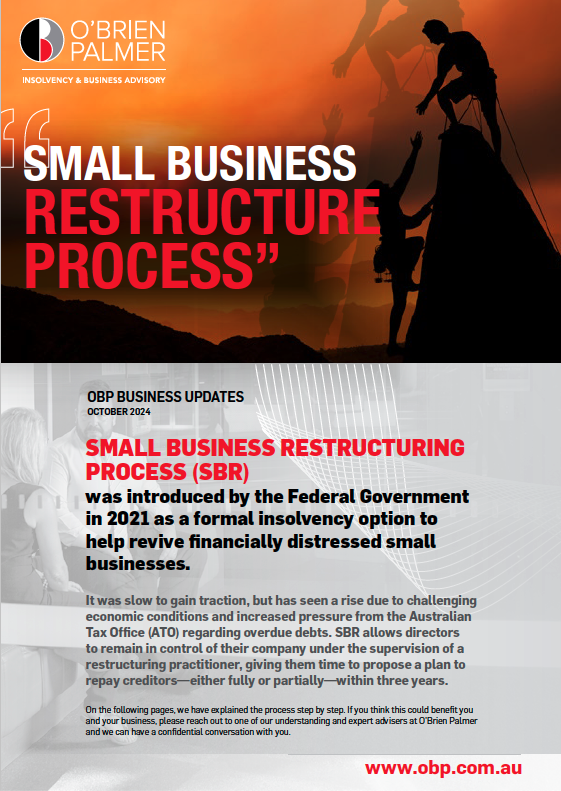SMALL BUSINESS RESTRUCTURING PROCESS
Small Business Restructuring Process (SBR) was introduced by the Federal Government in 2021 as a formal insolvency option to help revive financially distressed small businesses.
It was slow to gain traction, but has seen a rise due to challenging economic conditions and increased pressure from the Australian Tax Office (ATO) regarding overdue debts.
SBR allows directors to remain in control of their company under the supervision of a restructuring practitioner, giving them time to propose a plan to repay creditors—either fully or partially—within three years.
Below we have explained the process step by step. If you think this could benefit you and your business, please reach out to one of our understanding and expert advisers at O’Brien Palmer and we can have a confidential conversation with you.
1. PURPOSE OF THE SMALL BUSINESS RESTRUCTURE

The SBR process is governed by the operation of Part 5.3B of the Corporations Act 2001 (‘the Act”) and Part 5.3B of the Corporations Regulations 2001.
The purpose of an SBR is to allow an eligible business to compromise its debts with its creditors so as to maximise their chances of trading profitably in the future. An important feature is that it allows business owners to remain in control of their business during the restructuring period. During that time, they can, with the help of a Restructuring Practitioner (“RP”), use their experience and knowledge of the business to formulate a restructuring plan specific to the operation of that business.
2. ELIGIBILITY FOR BUSINESSES
Pursuant to section 453C of the Act and regulation 5.3B.03, a business is eligible to engage in the SBR framework if the company:
- is either insolvent or likely to become insolvent;
- has less than $1 million in total liabilities, ie admissible debts or claims (including tax debts, the unsecured portion of secured debts, but excluding employee entitlements not due and payable);
- its directors, or former directors acting in the previous 12 months, have not engaged with the SBR process or a simplified liquidation in the prior (7) years; and
- has not been under restructuring or been the subject of a simplified liquidation in the prior seven (7) years.
From a practical point of view, RP’s commonly add two (2) further requirements. Regulation 5.3B.24 provides that a company under restructuring must have:
- made payment of all employee entitlements due and payable; and
- fulfilled all required tax lodgements, including interim lodgements from the start of the current reporting period until the date of the RP’s appointment.
This regulation infers that these two (2) requirements may not need to have been met at the time of appointment. However, it’s a moot point because they need to be met before the plan is put to creditors.

3. THE SMALL BUSINESS RESTRUCTURING PROCESS

3.1 Appointment of Restructuring Practitioner
The directors must first conduct a review of the company’s financial position, cash flow budgets and future viability. If they are confident of the company’s future prospects, notwithstanding current cash flow issues, and the company is eligible for an SBR, then they can:
- resolve that the company is insolvent or likely to become insolvent;
- resolve that the company is eligible for restructuring;
- appoint an RP to oversee the process and to assist in the formulation of a restructuring plan.
The Company then moves to the restructure phase that comprises first the proposal period and then the acceptance period.
During these periods the restructure can end for a variety of reasons set out in regulation 5.3B.02 that include the company fails to propose a plan, the RP terminates the restructure, the plan lapses or the Court orders the restructure to end. If the plan is accepted by creditors, then the company moves to the next phase which is the implementation of the plan.

3.2 Restructure – Proposal Period
The proposal period usually lasts 20 business days but can be extended by the RP by a further 10 business days.
The Court can also extend the period. During that time, the directors will continue to manage the operation of the business and collaborate with the RP in the formulation of the restructuring plan. Intended transactions not in the ordinary course of business require the consent of the RP.
Pursuant to regulation 5.3B.50, the initial task of the RP is to issue an initial notice to creditors providing prescribed information about the appointment, generally pertaining to the SBR process and the impact on creditors. Thereafter, the RP will, inter alia:
- collaborate with the directors in formulating a plan and preparing a proposal statement;
- make reasonable enquiries to verify the company’s business, property, affairs and financial circumstances.
It’s important to note that the RP is not personally liable for debts incurred by the company during this period.
Once the plan is settled, regulation 5.3B.21 requires that the RP must issue a notice to creditors containing prescribed information about the proposed restructuring plan, including the provision of a copy of the plan which contains:
- details of the property of the company and specify how it is to be dealt with,
- how the RP is to be remunerated;
- the standard terms of the plans operations, such as how to manage defaults, etc.;
- a schedule of the company’s debts;
- a declaration from the RP that includes whether the company is eligible to restructure and whether it’s likely the company will to able to comply with the plan; and
- a voting form.
3.3 Restructure – Acceptance Period
The acceptance period usually lasts 15 business days but for a reason set out hereunder, the period can be extended. On receipt of the notice from the RP, creditors must:
- decide to either accept the plan or not accept the plan; and
- review the schedule of debts and decide whether they wish to either verify or dispute the amount owed. If they dispute the amount shown, then the form must be returned with five (5) business days otherwise they will be bound by the terms of the plan if it is approved.
If any creditor disagrees with the amount of their debt as shown on the schedule of debts, the acceptance period can be extended by a further five (5) business days.
Pursuant to regulations 5.3B.25 and 5.3B.26, the plan is accepted if a majority in value of creditors who vote agree to accept the plan. It takes effect at the end of the acceptance period unless the plan is conditional upon a specific event in which case when that condition is satisfied.
3.4 Plan Implementation
Pursuant to regulation 5.3B.55, the RP must issue a notice within two (2) business days advising that the plan has been accepted.
Thereafter the role of the RP is to deal with property of the Company as may be specified in the plan, monitor compliance with the terms of the plan, report contraventions, receive monies due under the plan and distribute monies to creditors.

4. EFFECT OF THE SMALL BUSINESS RESTRUCTURING PLAN
Regulations 5.3B.29 and 5.3B.30 set out the effect of a plan being approved, namely:
- The company, its officers, all admissible creditors and the RP are bound by the terms of the plan
- Secured creditors are bound for any shortfall in their security but not otherwise unless they consent to the plan;
- A plan does not prevent a secured creditor from realising or otherwise dealing with their security unless either the creditor voted to accept a plan that prevents it from doing so; or the Court so orders;
- A plan does not prevent an owner or lessor of property realising that property unless either the owner or lessor has accepted that plan or the Court so orders;
- Except with leave of the Court, a person bound by a plan cannot:
- make an application for an order to wind up the company based on an admissible debt;
- proceed with such an application made before the plan became binding on that person;
- begin or proceed with a proceeding against the company or in relation to its property to recover an admissible debt;
- begin or proceed with an enforcement process in relation to property of the company to recover an admissible debt.
5. TERMINATION OF THE SMALL BUSINESS RESTRUCTURE PLAN

Pursuant to regulation 5.3B.31, a plan terminates:
- on the day when the obligations of the Company and others have been fulfilled and all admissible debts have been dealt with under the plan;
- by Court order;
- if the plan is subject to the occurrence of a specified event within a specified time of not more than 10 business days after approval and the event does not occur within that period; then the next business day after the end of that period;
- if there has been a contravention of the plan and the contravention has not been rectified within 30 days after the contravention occurred, then the next business day after the end of that period;
- on the day in which an administrator, a provisional liquidator or a liquidator is appointed.
6. THE ATO AND SMALL BUSINESS RESTRUCTURING PLAN
The ATO recently published statistics that that show that;
- in 90% of appointments in which it holds sufficient power to determine the outcome of the SBR on its own; and
- it is approving approximately 90% of plans on which it votes that meet the eligibility criteria.
- where the ATO does not approve plans proposed, it does so where the company has a history of non-compliance with statutory obligations, where the company has been unable to satisfy its ability to comply with the obligations under the plan, or the proposal represents an intention to avoid paying tax properly owed.
In a recent information notice the ATO advised RP’s as follows:
- In relation to the two (2) requirements set out in point 2(a) and (b) above, the ATO will not vote to accept a plan where the company has unpaid employee entitlements and/or overdue tax lodgements.
- The ATO adopts the view that all admissible debts rank equally and that there is no ability for directors and related party creditors to exclude their debts under the plan unless the company has been released from the debt. The ATO will not vote to accept a plan that is inconsistent with this requirement.
- In order to make an informed decision in relation to a plan the ATO requires information pertaining to:
- the financial statements of the company for three (3) financial years prior to the appointment;
- the assets of the company as at the date of appointment;
- a dividend estimate in the event of liquidation. This would require commentary on the prospects of recovering money, property or other benefits should the company be liquidated;
- loan accounts with directors and related entities;
- financial forecasts if the plan involves contributions from future profits;
- the ability or capacity of a third party to make contributions if required under the plan.
- The ATO is open to providing feedback on a draft plan if the plan and all supporting documentation is provided not less than five (5) days prior to the plan is due to be issued to creditors.
7. CONCLUSION
The SBR process offers several key advantages for struggling small businesses. It provides a streamlined, cost-effective method for companies to restructure their operations while avoiding the more cumbersome and expensive processes associated with formal insolvency.
By allowing businesses to propose and implement a plan to return to profitability, the SBR helps preserve jobs, maintain business value, and ensure continuity of operations. It also offers protection from creditors during the restructuring period, giving businesses the time and space they need to reorganize and address financial difficulties without the immediate threat of liquidation.

Watch our recent videos on the
Small Business Restructure Process
INFORMATION ON THE PROCESS
Released October 2023.
Read our blog.
INFORMATION ON THE PROCESS –
12 MONTHS LATER
Released October 2024.
Read our blog.
WANT TO STAY IN TOUCH
DO YOU WANT TO JOIN OUR MAILING LIST AND STAY UP TO DATE?
